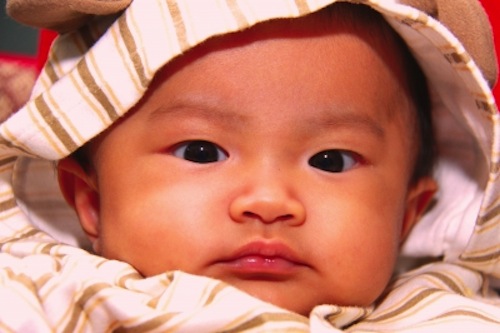5 Ways to Make Your Baby Smile
If your baby just started smiling, you want to see that beautiful, cheeky smile all the time. Sometimes babies smile at new faces, but sometimes they enjoy looking at familiar ones. It can be tough to predict exactly what will make a baby smile, but Mom Trusted has a few tricks up our sleeve. Try these five ways to make your baby smile:
Go for the colors
Babies’ brains are still developing as they take in everything around them in their new, exciting world. Colors are one thing that can excite and catch a baby’s eye. Introduce your baby to colorful toys and items they can hold onto when they start being able to successfully grab objects at around three or four months.
Play with feathers
There’s nothing like a good tickle to get a baby laughing. Try using pretty, colorful feathers, which work great for babies who may not enjoy aggressive tickling the traditional way.
Make funny faces
Your face is your baby’s favorite to look at so your face making goofy faces may be the key to uncontrollable giggles. Try adding peek-a-boo to your silly faces to make your baby smile even more.
Belly raspberries
Make your baby smile by making raspberries on his or her tiny belly. (These are also called zerbits or belly bubbles).
Sing to your baby
Try singing a lullaby, a silly song or even one on the radio to your little one. People of all ages love music and, because music is still a new phenomenon for your child, it might be just the trick you need to make your baby smile. Over time, you’ll start to experiment and find out which songs make him or her smile most and even establish favorite types of music.
Sources:
-“9 Ways to Make Your Baby Laugh” parenting.com: http://www.parenting.com/gallery/9-ways-to-make-your-baby-laugh?pnid=108127
-“5 Ways to Make Your Baby Laugh” Yahoo! Voices: http://voices.yahoo.com/5-fun-ways-baby-laugh-4090891.html
-“7 Ways to Make a Baby Laugh” The Stir: http://thestir.cafemom.com/baby/135281/7_ways_to_make_a
-Photo courtesy of koratmember/freedigitalphotos.net
5 Everyday Objects that Your Baby Will Love to Play With
Sometimes we get so caught up with the cool, new technological baby toys that we forget how much fun they can have with simple, everyday objects. Babies’ curiosity makes simple items lying around the house new adventures. Here are a few to explore with your little one:
Scarves
That pile of scarves sitting in your closet is more than just a bunch of accessories. It’s a great way to make your little one smile. Not only do babies love the silky texture of scarves, but the colorful, bright patterns are sure to catch their eye. Try throwing them around so your baby can watch them twirl around in the air.
Pots and Pans
Just like in the movies, babies love the sound of banging on some pots and pans. Grab a spoon or spatula, some pots or pans and let your little one rock out. OK, so we know the noise can be enough to cause a migraine, so just make sure that you set aside a short time period and stick to it.
Plastic Cups
Safe and simple- babies love stacking plastic cups. Grab a variety of sizes and colors and set them out in front of your little one. The best part? They make for a fast cleanup!
Tupperware
Grab some Tupperware with lids and show your baby how to snap them on. They’ll have a blast matching up the right ones.
Cardboard Boxes
Grab some big cardboard boxes and make a tunnel for your baby to crawl around in. Let them hide under them and cruise through them.
Sources:
-“11 Fun Activities for When Winter Weather Traps You Indoors.” Parents.com
-“5 Unexpected Household Items that Babies Love to Play With.” Yahoo Shine
-Photo courtesy of Stuart Miles/freedigitalphotos.net
New Study Shows Pacifiers May Stunt Emotional Growth in Boys
Researchers at the University of Wisconsin, Madison found that pacifiers might stunt emotional development, but only in boys. Psychologists at Wisconsin led three experiments connected low emotional maturity to heavy pacifier use as a child.
Psychologists believe the nookies may make it difficult to imitate adult’s facial expressions, a skill that children are perfecting at the binky age. The theory held true for both the six and seven-year-olds and college-aged males that the researchers studied.
The six and seven-year-olds were measured by the amount they mimicked expressions on a video and college males took perspective taking tests. Both experiments were meant to mimic empathy. And in both cases, those who reported heavy pacifier use as children scored lower.
Girls, however, showed no direct correlations between emotional maturity and pacifier use as a child. It may be due to the fact that girls tend to develop earlier, but the reason remains a mystery.
This problem only occurs when facial expressions are being utilized. During times like nap and bedtimes, children are sleeping so expression mimicking is not happening. So even though it may be wise to wean boys off of binkies, this doesn’t mean that parents of baby boys should ditch pacifiers completely.
Sources:
-University of Wisconsin, Madison news releases. 9/18/12.
-Photo courtesy of Carlos Porto/freedigitalphotos.net
20 Fun Baby Facts
1. Some babies can start to recognize a mother’s voice at as early as two days old.
2. Four out of 10 babies have at least one birthmark when they’re born.
3. We have 206 bones, but babies are born with 300 because many fuse together as they grow.
4. Crying helps calm babies down because tears release a stress hormone. However, it takes between three weeks and five months for babies to actually develop tears when crying.
5. Babies quickly lose any hair that they’re born with.
6. Smiling isn’t just copying, but rather something that comes naturally to babies. The fact that blind babies smile proves it!
7. The most popular day for childbirth in the U.S. is Tuesday.
8. A newborn’s heart beats about twice as fast as an adult’s.
9. All babies are born prematurely and some doctors refer to their first few months of life as the fourth trimester.
10. Over four million babies are born each year in the U.S.
11. Newborns have poor eyesight and can only focus on objects about eight inches away. They are not, however, colorblind, contrary to popular belief.
12. Baby tummies are tiny. An eight-pound baby can only drink about three ounces of milk at a time.
13. A baby is born somewhere in the world every three to five seconds.
14. Newborns don’t sweat. Their sweat glands have yet to fully develop.
15. Almost all babies are born with blue eyes and a pug nose.
16. Babies’ sense of smell is much stronger than adults’. They use this to get to know their mothers early on.
17. After only a few days, mothers can distinguish their children’s cries from those of other babies.
18. Babies are born without kneecaps.
19. Infants learn emotions by imitating adults’ expressions.
20. Baby brains double in size during the first year.
Sources:
-“Surprising facts about birth in the United States.” Baby Center.
-“21 fascinating facts about your baby.” Bounty.com.
-“25 facts you should know about a newborn baby.” Milliontalks.com
-“Fun Baby Facts.” Kinderpods.
-Nixon, Robin. “11 Facts Every Parent Should Know About Their Baby’s Brain.” Live Science.
-Photo courtesy of koratmember/freedigitalphotos.net
















